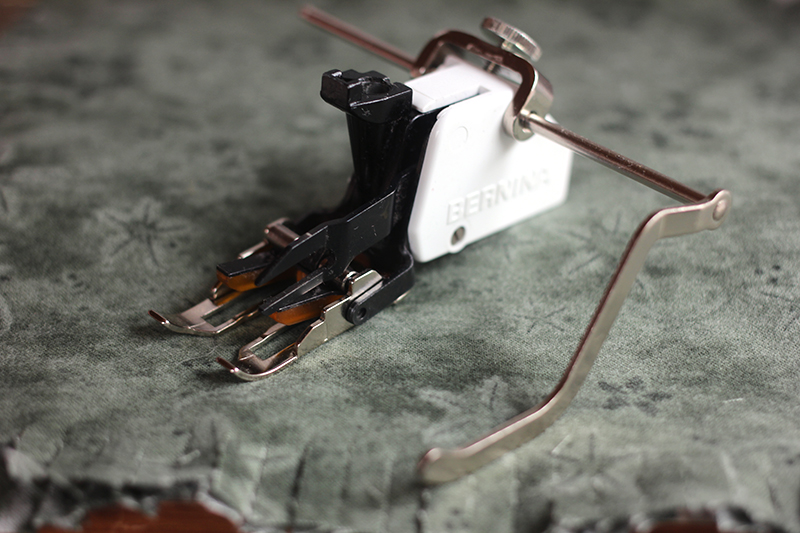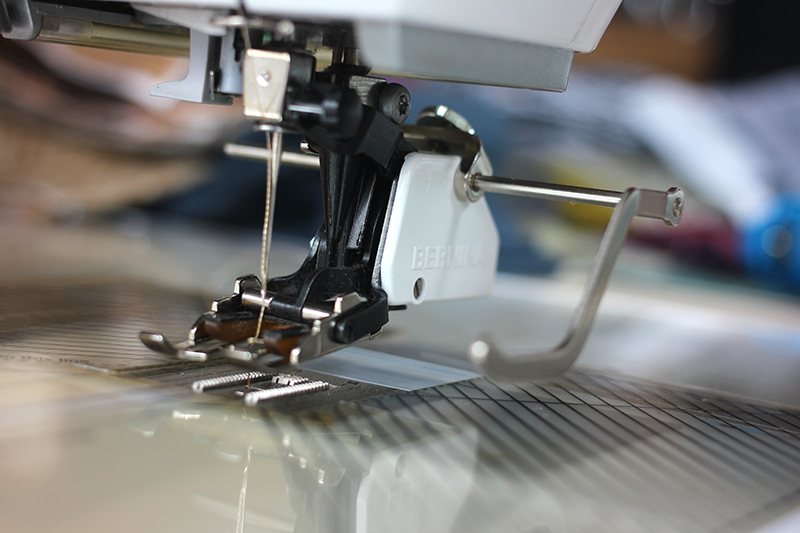These Feet Were Made for Quilting
Some call it the quilting foot, it’s also widely known as the walking foot. A walking foot attachment for your sewing machine evenly feeds all three layers of your quilt through your machine during quilting. First time walking foot users will want to refer to the manufacturer instructions for installation. Walking feet are often used for straight line quilting, and will often have a channel guide that you can attach to ensure parallel quilting is evenly spaced. These feet come with two attachments for the foot, a standard one and an open toe one for quilting.Using a Walking Foot
Let’s set a scenario for you. You are quilting with your standard foot, not a walking foot, and as you quilt your project is moving through the feed dogs that lie just beneath your presser foot. The feed dogs are doing their job, but that standard foot that you use for piecing is not doing anything but resting atop your quilt. You really don’t notice anything unusual until you are done. It’s really hard not to notice that you now have a puckered, very unappealing mess! If this same process was used with a walking foot your outcome would have been very different. The foot actually works with your feed dogs, gently feeding your fabric through with its own feed dogs on the bottom of the foot. Working together, the feed dogs and foot work the layers evenly through the machine. The end result is a beautifully quilted project.How to Prepare a Walking Foot
- Install a new needle. I use a quilting needle or Microtex Sharp size 75/11 or 80/12. I choose these needles because they work well with the thread I recommend (see below).
- Set your stitch length to 2.5 to 3mm.
- Adjust your foot pressure setting. Not all machines have this capability; if yours does it is likely marked on the front head of your machine.
- If your machine has a needle down setting, use it now.
- Thread your machine using 50wt. in top and bobbin, unless you prefer bottom line or another form of bobbin thread. I like to use 100% cotton but have tried Filtec Glide recently and really liked the appearance. Other great threads are Aurifil, Masterpiece, So Fine, or Presencsia.
- Use a practice quilt sandwich to ensure your stitches are as you want them before beginning on your project. Once you get a couple practice stitches in and make any desired adjustments, you’ll be ready to quilt!
Things to Consider When Purchasing a Walking Foot
- Have your machine manufacturer and model handy when you purchase your foot. Sometimes you can purchase a generic foot if your manufacturer no longer makes the foot.
- Know if you have a high, low, or slant shank on your machine. The shank is the portion of the machine your foot attaches to.
- Get the standard attachment and the open toe attachment.
- Is there a channel guide attachment with the walking foot? Channel guides fit into the foot and allow you to quilt parallel lines that are equally spaced. You mark the first line and quilt on that line. You will then rest the channel guide on the line while quilting your next line.
- Because it is a mechanical foot, it will wear out. Keep in mind you might need to replace it depending on how often you use it. The fork that fits around the clamp screw is likely the most fragile part. Be sure to store to prolong the life of the foot.
Other Great Uses for Walking Feet
- Attaching binding to your quilt
- Helpful in matching plaids
- Useful when sewing bias cut fabric pieces
- Great for rag quilts
- Helpful for sewing fabrics such as minky, knits, or fleece
- Quilting stitch in ditch
- Ensures even stitching
The Right Needles for Your Sewing Machine
Choosing the Right Quilting Thread
Sewing Machine Troubleshooting
Have something to add? Leave a comment or email editor@nationalquilterscircle.com.


I have 2 walking feet, open and closed, I prefer the open. The only thing I don't like is the guide. Sometimes I would like to use on the left side, not always on the right.
I just got a Singer Even Feed Foot for my Singer Genie. The Presser Foot lifter hits the top of the foot and sometimes gets stuck. Any suggestions?
<strong>You mentioned adjusting the foot pressure setting. How/why should you change it? Also, would you start quilting going all in the same direction, and break thread and go back to the same side to start tje next side?
My walking foot makes tiny stitches regardless of the stitch length it is set at. Does this mean time for a new one??
I have a dual feed power foot with my Dream machine it is the best thing, the roller helps move the fabric through with no problems, I'm a beginning quilter and this has made life easier for me
<strong> HI, I HAVE A BROTHER HC1850 WHAT WOULD BE THE RECOMMENDED FOOT PRESSURE SETTING WHEN USING A WALKING FOOT?
I have an old, reliable Stretch and Sew machine, made by Vibrante. Instructions for walking foot are non-existent. What kind of walking foot do I need? And where do I buy one? Thanks!
I got a kenmore sewing machine model # 385.19550 what walking foot should I use? I love at the quilt.</strong>
Should I use the walking foot when I am piecing the quilt top?
What settings should your machine on be on to top stitch a baby quilt?